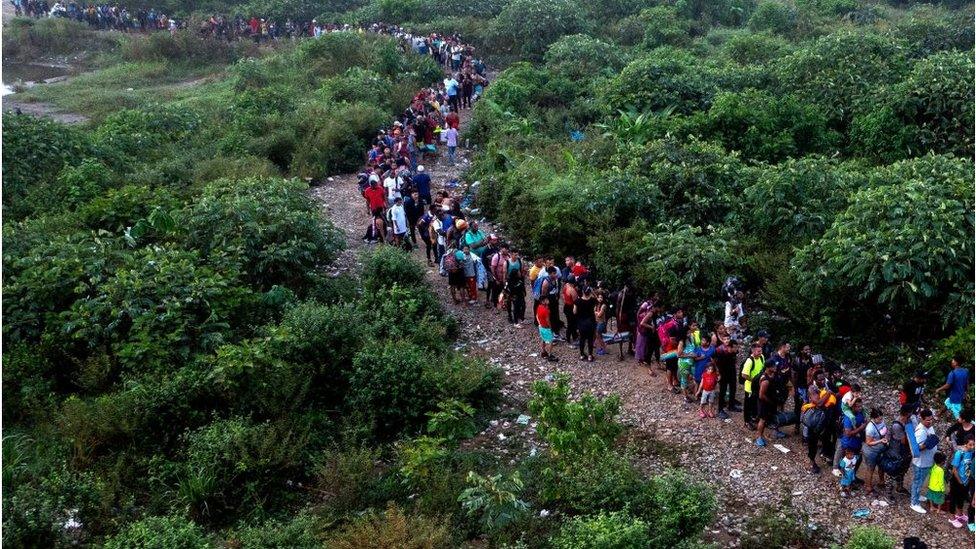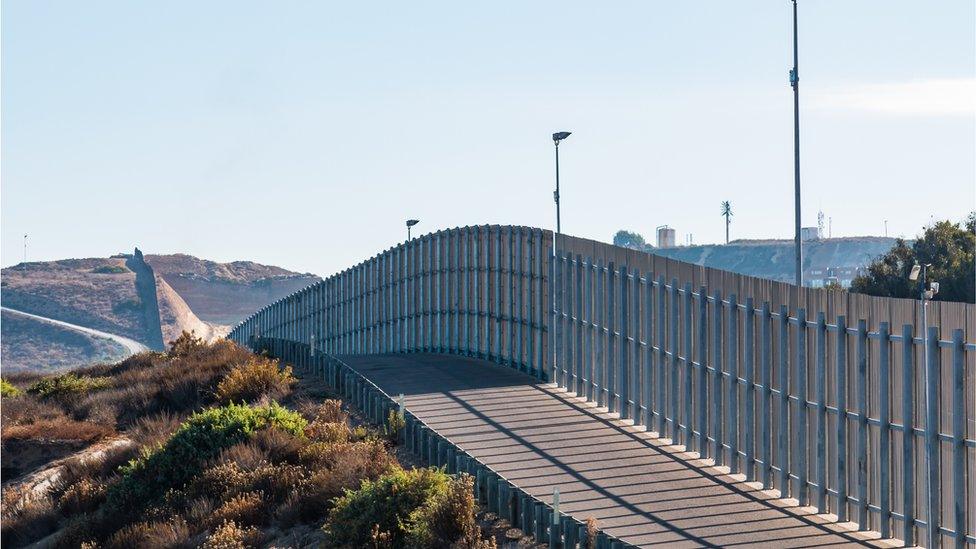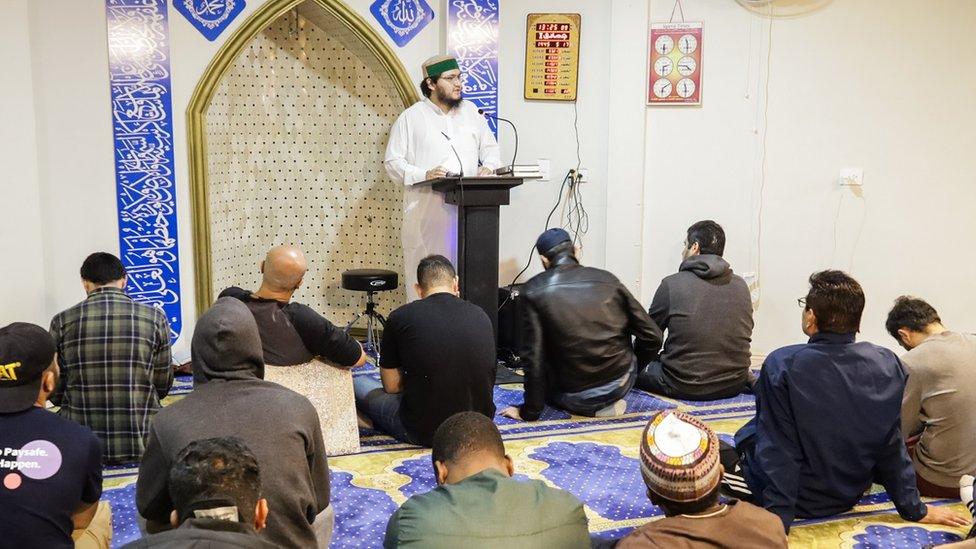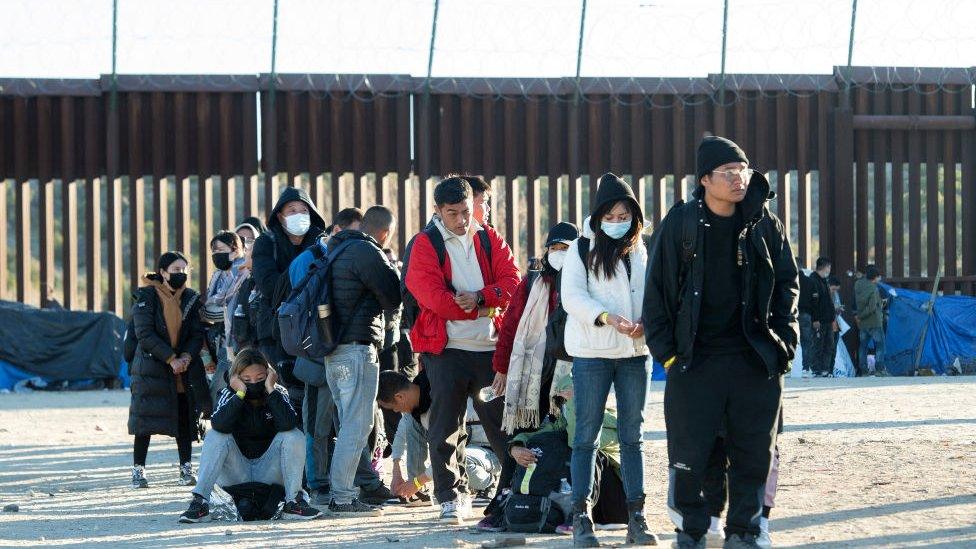The Afghan refugees stuck in limbo at the US-Mexico border
- Published

Shukriah, a journalist, fled Afghanistan after the Taliban took power
A stone's throw from the US border and around the corner from Tijuana's seedy red-light district, Afghan families say they feel safe inside a first of its kind Muslim-only shelter.
But they are afraid to wander far outside, traumatised by their journey across 11 countries to get here.
Desperate to make it to the US after the Taliban takeover more than two years ago, they say they had no future in Afghanistan - their work alongside US allies made them targets.
So they fled, enduring months of waiting in Iran and Pakistan.
They flew to Brazil and then crossed the treacherous Darién Gap of Panama on foot, where they were robbed and assaulted.
One group of Afghans was forced to strip naked - men and women together - as masked gunmen searched them for hidden money, Shukriah says through tears.
A journalist, she shows photos on her phone of her nine-year-old daughter with a bruised eye. The men punched and beat her children, she says, until they got more money from the group.
"It's very hard to talk about it," she says, as her children play nearby.
The Albergue Assabil/Mesquita Taybah shelter, where Shukriah now lives, is noisy and full of life. The kitchen is bustling with men cooking rice, ground beef and beans with cumin and turmeric.
The children play with a ball in a small courtyard but have no space to run. They have not attended school since they left Afghanistan.

Many migrants say they were assaulted on the treacherous journey across the Darién Gap in Panama
The Afghans in the shelter are desperate to restart their lives in the United States - if they can figure out how to claim asylum. Some have been waiting for more than two months for an appointment with US authorities.
Some migrants wonder if they should cross illegally. They have heard others pass through gaps in the border wall and get processed quickly. But most migrants want to do the right thing.
"We were left behind," says Sofia, who was a student at the American University in Kabul, which was funded by the United States.
Sofia - like others in the shelter - does not want her real name used for fear that it will hurt her chances of entering the US or have repercussions for her family left behind in Afghanistan.
When Afghanistan fell to the Taliban in 2021, thousands of Afghans flooded the airport in Kabul, passing babies to the front of the line and waving paperwork to prove their work alongside the US-backed government.
They were desperate to catch a US evacuation flight.
Sofia says the US embassy offered her a flight out. But in the chaos that erupted, she could not make it through the crowds to get to the airport.
Instead, she went to Iran and then Pakistan, where, she says, US officials told her to file paperwork to emigrate.
After eight months, she still had not heard anything, so with a group of family and friends she flew to Brazil and began her journey across the Americas - by foot, bus, boat and taxi.
Sofia did not travel with Shukriah, but she was also robbed in the Darién Gap between Panama and Colombia as were other migrants we spoke to.
Many migrants pay smugglers to take them through Panama - it has become a booming business there. But the Afghans relied on social media instructions to cross the Darién Gap, following blue plastic signs and avoiding red signs, which indicate danger.

The border wall between Tijuana and San Diego is a short walk from the shelter the Afghans are staying in
And they just followed the crowd: thousands of people from China, India, Pakistan, Cameroon. A record number of migrants now passes through the dense stretch of jungle once considered impassable.
"It's so dangerous," Sofia says, adding that she would never have travelled that way had she known.
At night, they could hear wild animals and were terrified. During the day, it poured with rain, the river would flood and they had to walk up mountains, often carrying their children and everything they own. Armed men took their money and jewellery. They feared a deadly snake bite.
One man traveling alongside them drowned trying to cross the river, Sofia says.
She heard stories of women being raped and saw two severed hands discarded by the river and countless dead bodies along the way.
"We used to cry. "What happened to these people? Maybe they died because of the floods, or maybe some animals attacked them, or the gunmen shot them. No one knows."
They can now see the United States when they step foot outside the shelter. They can walk a few hundred feet to touch the border wall. But even after all they have been through, they say the wait is torture.
To seek US asylum, migrants are expected to use a mobile app called CBP One to get an appointment with US Customs and Border Protection.
The app was meant to simplify the asylum process, but it has not.
Migrants and human rights groups say it does not work properly, leaving vulnerable people stuck for months in Mexico trying to get an appointment.

The Latina Muslim Foundation shelter offers halal food, separate dormitories for men and women and daily prayers
It could soon become even more difficult to claim asylum once migrants do get an appointment.
In Washington DC, some Republicans in Congress will not approve aid to Ukraine and Israel if the Biden administration does not tighten border restrictions and make it more difficult to claim asylum in the US.
Even the Afghans who were evacuated to the US face uncertainties. The Biden administration extended temporary visas for them earlier this year, but many remain living in limbo, uncertain about their future immigration status.
Ten years ago, it was rare to see migrants from Asia or Africa in Tijuana's shelters, but now the whole world comes to the border towns along the southern US.
That's why the Latina Muslim Foundation opened this shelter in 2022 to cater to the growing group of Muslim migrants, to provide a shelter, halal food, separate dormitories for men and women and daily prayers.
Sofia has been waiting two months in the shelter - trying every day to get an appointment.
"I have no option but to wait," she says, adding that she has nowhere else to go and she cannot go back to Afghanistan because the Taliban know she is "a US ally".
- Published9 December 2023

- Published5 December 2023
